“Revolutions from 1815-1914” – Everything You Need to Know
Between the end of the Napoleonic Wars and the outbreak of World War I, Europe and other parts of the world experienced a series of transformative upheavals that reshaped political orders, social structures, and economic systems. This era, encapsulated by the keyword “Revolutions from 1815-1914”, witnessed a diversity of revolutionary movements—from liberal and nationalist uprisings to socialist and agrarian revolts. In this comprehensive guide, we will explore these revolutionary episodes in depth, tracing their origins, examining their key characteristics, and understanding their lasting impact on modern society.
Introduction: A Time of Radical Change
Imagine a world where old empires were crumbling, new ideas were spreading like wildfire, and the very notion of state and society was being reimagined. Did you know that during the period from 1815 to 1914, revolutionary fervor ignited changes in nearly every corner of Europe—and beyond? The revolutions during this era not only challenged established authorities but also laid the groundwork for modern democratic, national, and socialist movements.
In today’s post on “Revolutions from 1815-1914”, we will cover:
- A clear and thorough definition of these revolutions and their essential characteristics.
- The historical context and critical milestones that set the stage for these uprisings.
- An in-depth exploration of key revolutionary movements, with case studies and real-world examples.
- The significance and long-term benefits of understanding these revolutionary waves.
- Addressing common misconceptions and frequently asked questions.
- A discussion on modern relevance and current debates inspired by these historical events.
By exploring “Revolutions from 1815-1914”, we not only gain insight into the forces that redefined nations and societies but also learn how these historical events continue to influence contemporary political and social life.
What Are “Revolutions from 1815-1914”?
Defining the Concept
“Revolutions from 1815-1914” refers to the series of political, social, and economic upheavals that occurred between the end of the Napoleonic Wars and the beginning of World War I. These revolutions were marked by several key characteristics:
Political Overthrow and Reform:
Many of these movements sought to challenge and overthrow established regimes, whether they were absolutist monarchies or emerging empires, aiming instead to establish liberal constitutions, democratic institutions, or nationalist states.Social and Economic Transformation:
The revolutions often targeted not just political power but also the deep-seated social hierarchies and economic inequalities. Radical ideas, from socialism to agrarian reform, took root in many regions.Ideological Diversity:
The period saw a broad spectrum of revolutionary ideologies—from liberalism and nationalism to Marxism and anarchism. These ideologies influenced the nature and direction of the revolutions.Cross-Border Influences:
Revolutionary ideas spread quickly across national boundaries, influencing events in multiple countries and contributing to a shared spirit of change. This transnational influence is a defining feature of the period.Complex Legacies:
While some revolutions led to lasting reforms and the establishment of new political systems, others were suppressed or resulted in mixed outcomes, leaving a complex legacy that continues to inform modern political thought.
Understanding these core properties is essential to appreciate the multifaceted nature of “Revolutions from 1815-1914” and their enduring impact on our world today.
Historical and Contextual Background
The Post-Napoleonic Order and the Seeds of Revolution
At the close of the Napoleonic Wars in 1815, Europe was left scarred by years of conflict and transformation. The Congress of Vienna aimed to restore stability and balance of power, yet the seeds of revolutionary change were already sown. Discontent simmered beneath the surface due to various factors:
Reaction to Restoration:
The restoration of pre-revolutionary monarchies was seen by many as a return to oppression rather than a true solution to the social and political grievances unleashed by the French Revolution.Rise of Nationalism:
As modern nation-states began to emerge, diverse ethnic and cultural groups increasingly demanded self-determination and the right to govern themselves, fueling nationalist movements.Economic Disparities:
The Industrial Revolution, while boosting productivity, also deepened economic inequalities. The burgeoning urban working class, along with disenfranchised peasants, sought reforms to address these imbalances.Liberal Ideals:
The spread of Enlightenment ideas promoted individual rights, constitutional government, and the rule of law, challenging the traditional autocratic systems that dominated much of Europe.Intellectual Ferment:
Thinkers such as John Stuart Mill, Karl Marx, and Mikhail Bakunin contributed ideas that questioned existing social orders and provided the theoretical underpinnings for later revolutionary movements.
Milestones Leading Up to 1914
Several key events and trends in the 19th century set the stage for the revolutions that would follow:
- The Revolutions of 1830:
- The July Revolution in France led to the overthrow of King Charles X and the establishment of a constitutional monarchy. This revolution served as an inspiration for subsequent uprisings across Europe.
- The Revolutions of 1848:
- Often called the “Springtime of Nations,” the widespread uprisings in 1848 affected France, the German states, the Italian peninsula, and the Austrian Empire. These revolutions aimed to secure liberal reforms, national unification, and social justice, though most were ultimately suppressed.
- Unification Movements:
- The mid-19th century saw the unification of Italy and Germany, as nationalist movements succeeded in merging fragmented states into cohesive nations. These revolutions were as much about forging national identities as they were about political reform.
- The Rise of Socialism and Marxism:
- In the latter half of the 19th century, as industrialization advanced, the exploitation of labor became more evident. This led to the emergence of socialist movements and the publication of Marx’s seminal work, The Communist Manifesto, which inspired revolutionary ideas worldwide.
- Late 19th to Early 20th Century Upheavals:
- As the century turned, tensions continued to build. The rapid pace of technological change, economic upheaval, and imperial competition created fertile ground for further revolutionary sentiment, culminating in the geopolitical crises that eventually led to World War I.
In-Depth Exploration of Revolutions from 1815-1914
To fully understand “Revolutions from 1815-1914”, it is essential to delve into their multifaceted nature. In the sections below, we break down the revolutionary period into key themes, movements, and case studies.
1. Political Revolutions: Overthrowing the Old Regimes
a. Liberal Revolutions and Constitutional Movements
One of the most significant aspects of this period was the quest for constitutional government and the rule of law. Liberal revolutions sought to replace absolute monarchies with systems that respected individual rights and separated powers.
The French July Revolution (1830):
- Context: In response to the repressive policies of the Bourbon monarchy, the French populace revolted in July 1830.
- Outcome: King Charles X was overthrown, and a constitutional monarchy was established under Louis-Philippe.
- Impact: The success of this revolution inspired similar movements across Europe and underscored the demand for political modernization.
The Polish Uprisings:
- Context: Throughout the 19th century, Poland, partitioned among Russia, Prussia, and Austria, experienced multiple uprisings as its people sought independence and self-determination.
- Outcome: Although these revolts were largely suppressed, they kept the spirit of nationalism alive and laid the groundwork for future struggles for independence.
- Impact: The persistent Polish resistance highlighted the role of nationalism in driving revolutionary change.
b. Nationalist Movements and the Unification of Nations
Nationalism emerged as a powerful force during this period, challenging the old imperial orders and leading to the unification of fragmented states.
Italian Unification (Risorgimento):
- Key Figures: Leaders such as Giuseppe Garibaldi, Count Camillo di Cavour, and King Victor Emmanuel II spearheaded the movement.
- Outcome: By 1871, the disparate Italian states were unified into the Kingdom of Italy.
- Impact: The Italian unification revolution not only reshaped the political map of Europe but also influenced nationalist movements in other regions.
German Unification:
- Key Figures: Otto von Bismarck, the Prussian statesman, played a central role in unifying the German states through a series of wars and diplomatic maneuvers.
- Outcome: In 1871, following the Franco-Prussian War, the German Empire was proclaimed in the Hall of Mirrors at Versailles.
- Impact: German unification was a turning point in European history, as it dramatically altered the balance of power and set the stage for future conflicts.
2. Social and Economic Revolutions: Transforming Society from Within
a. The Rise of the Working Class and Socialism
The rapid industrialization of the 19th century brought profound changes to the economic landscape. The exploitation of labor, harsh working conditions, and stark economic inequalities gave rise to a new social consciousness.
Early Labor Movements:
- Context: As factories proliferated, workers began to organize to demand better conditions, fair wages, and shorter working hours.
- Impact: These early labor movements laid the foundation for trade unions and collective bargaining—a legacy that continues to influence labor laws today.
The Influence of Marx and Engels:
- Key Text: The Communist Manifesto (1848) provided a powerful critique of capitalist society and called for the proletariat to unite and overthrow the bourgeois order.
- Impact: Although not all socialist movements resulted in immediate revolutions, Marx’s ideas fueled a century-long debate over the nature of economic justice and the role of the state in regulating industry.
b. Agrarian Revolts and Rural Transformations
While much of the focus is on urban industrialization, revolutions from 1815-1914 also included significant agrarian components. Peasant uprisings challenged feudal structures and demanded land reform.
- The 1848 Revolts in the Austrian Empire:
- Context: Discontent among peasants and urban workers alike led to widespread protests against feudal practices and autocratic rule.
- Outcome: Although many of these revolts were suppressed, they forced authorities to consider reforms that would eventually transform rural economies.
- Impact: These uprisings played a crucial role in ending feudal practices and paved the way for modern agricultural policies.
3. Ideological and Cultural Revolutions: Shaping Minds and Hearts
a. The Spread of Enlightenment Ideas
The intellectual ferment of the Enlightenment continued to influence revolutionary thought throughout the 19th century. Ideas about individual rights, the social contract, and rational governance provided the ideological underpinning for many revolutionary movements.
- Influence on Political Reform:
- Concepts such as liberty, equality, and fraternity, first popularized during the French Revolution, continued to resonate and evolve during this period.
- Impact: These ideas drove reforms in legal systems, education, and government institutions that aimed to create more egalitarian societies.
b. Artistic and Literary Reflections
Revolutionary movements inspired a rich body of art and literature that reflected the hopes, fears, and aspirations of the era.
- Romanticism and Nationalism:
- Context: Romantic writers and artists celebrated national myths, historical heroes, and the beauty of the natural landscape, often in opposition to the industrialized, mechanized world.
- Impact: This cultural movement not only provided emotional support for nationalist causes but also helped forge a distinct cultural identity for emerging nation-states.
- Realism and Social Critique:
- Context: As industrial society revealed its harsh realities, realist literature and art depicted the struggles of everyday life, shedding light on social injustices.
- Impact: These works contributed to public debates about reform and influenced political agendas across Europe.
Importance, Applications, and Benefits
Understanding “Revolutions from 1815-1914” is not merely an academic exercise—it offers valuable lessons and insights that resonate in today’s society.
a. Shaping Modern Political Institutions
Democratic Governance:
The revolutions of the 19th century played a crucial role in dismantling absolute monarchies and paving the way for constitutional, representative governments. Many modern democracies trace their roots back to these transformative events.Rule of Law and Human Rights:
Revolutionary movements emphasized the importance of legal equality and individual rights, concepts that remain central to contemporary political discourse and international human rights frameworks.
b. Influencing Economic and Social Policies
Labor Rights and Social Welfare:
The struggles of the working class during the revolutionary period led to the establishment of labor laws and social safety nets that continue to benefit millions of people today.Land Reforms and Agrarian Policies:
Agrarian revolts helped end feudal systems and led to land reforms, contributing to more equitable economic development in rural areas.
c. Inspiring Cultural and Intellectual Movements
National Identity and Cultural Expression:
The nationalist movements that emerged during this period have had a lasting impact on cultural identity and the arts. Understanding these revolutions helps explain the evolution of national consciousness and artistic expression.Debates on Social Justice:
The revolutionary calls for equality and justice continue to inspire modern debates on social reform, influencing movements that address contemporary issues such as economic inequality and social exclusion.
d. Lessons for Modern Change
Incremental vs. Radical Change:
The diverse outcomes of revolutions from 1815-1914 highlight the complexities of social transformation. Some movements achieved gradual reform, while others attempted radical overhauls with mixed results. These lessons are invaluable for contemporary policy-makers and activists.The Role of Ideology:
The ideological debates of the 19th century—between liberalism, nationalism, socialism, and conservatism—still inform modern political discourse. Understanding these roots helps explain current political divides and debates.
Addressing Common Misconceptions and FAQs
Despite their historical significance, “Revolutions from 1815-1914” are often misunderstood. Here, we address several common misconceptions:
FAQ 1: Were all revolutions during this period inherently violent?
- Misconception:
Many assume that all revolutionary movements were marked by indiscriminate violence and chaos. - Reality:
While some revolutions involved significant violence, others were characterized by peaceful protests, intellectual debates, and gradual reforms. The nature of each revolution depended on a variety of factors, including leadership, social context, and external pressures.
FAQ 2: Did these revolutions completely overthrow existing systems?
- Misconception:
There is a common belief that revolutions invariably led to the complete dismantling of old regimes. - Reality:
In many cases, revolutions resulted in partial reforms rather than complete overthrow. Existing power structures were often adapted and reformed rather than entirely replaced, leading to hybrid systems that combined old and new elements.
FAQ 3: Were revolutions from 1815-1914 limited only to Europe?
- Misconception:
Some view these revolutions as solely European phenomena. - Reality:
While Europe was the epicenter, the ideas and outcomes of these revolutions influenced movements in Latin America, Asia, and other regions, contributing to a global wave of change.
FAQ 4: Is the study of these revolutions relevant to today’s world?
- Misconception:
Critics sometimes argue that historical revolutions have little bearing on modern society. - Reality:
The legacy of these revolutions is evident in contemporary political systems, social reforms, and cultural movements. They offer enduring lessons about the nature of change, the role of ideology, and the dynamics of power.
Modern Relevance and Current Trends
a. The Continuing Impact on International Relations
The revolutionary period from 1815 to 1914 laid the groundwork for the modern nation-state system and continues to influence international relations today. Many of the diplomatic and political principles that emerged during this era—such as self-determination, sovereignty, and the rule of law—remain central to global politics.
Globalization and Nationalism:
Modern nationalist movements often draw on the historical narratives of 19th-century revolutions. Debates over national identity, borders, and sovereignty can be better understood in the context of these earlier struggles.International Institutions:
The formation of international organizations and agreements, such as the United Nations and various human rights treaties, is rooted in the revolutionary ideals of equality and justice that emerged during this period.
b. Lessons for Social and Political Reform
The debates and outcomes of “Revolutions from 1815-1914” continue to inform discussions about social justice, economic inequality, and democratic governance. Contemporary movements for political reform, labor rights, and environmental justice can all draw lessons from the successes and failures of past revolutions.
Gradual vs. Radical Reform:
Modern policy-makers often grapple with the question of how best to achieve change. The history of these revolutions provides valuable insights into the advantages and disadvantages of both incremental and radical approaches.The Role of Technology and Communication:
While the 19th-century revolutions relied on pamphlets, newspapers, and public speeches, today’s movements harness digital technology to mobilize support. Despite these differences, the underlying principles of political activism remain remarkably similar.
c. Cultural and Educational Implications
Understanding the revolutionary transformations of 1815-1914 enriches our cultural and intellectual heritage. Educators and students alike benefit from studying this era, which offers profound lessons on human resilience, creativity, and the power of ideas.
Curriculum Development:
Incorporating the history of these revolutions into educational programs can foster critical thinking, civic engagement, and an appreciation for democratic values.Public Discourse:
A well-informed public that understands the historical context of contemporary issues is better equipped to participate in democratic processes and hold leaders accountable.
Conclusion: Reflecting on a Pivotal Century of Change
Summarizing the Key Points
“Revolutions from 1815-1914” represent a dynamic and transformative period that reshaped the world in profound ways. Key takeaways include:
Political Transformation:
From liberal revolutions in France to the unification movements in Italy and Germany, this era witnessed the dismantling of old regimes and the birth of modern nation-states.Social and Economic Upheaval:
The rise of industrial capitalism, the struggles of the working class, and agrarian revolts led to significant reforms in labor, land, and social welfare.Ideological Debates:
The period was marked by competing ideologies—liberalism, nationalism, socialism, and conservatism—that continue to influence political discourse today.Cultural Legacy:
The art, literature, and philosophical reflections of the time provide enduring insights into the human condition and the pursuit of justice and equality.Modern Relevance:
The lessons from these revolutions remain vital in understanding contemporary issues such as governance, social reform, and international relations.
Reinforcing the Importance of Understanding This Era
Grasping the history and impact of “Revolutions from 1815-1914” is crucial for anyone interested in the forces that have shaped our modern world. By studying these revolutionary episodes, we can better understand:
- How political and social change occurs.
- The interplay between ideology, economic systems, and cultural transformation.
- The enduring legacy of historical movements in shaping modern policies and institutions.
A Call-to-Action
We invite you to:
- Explore Further:
Delve into detailed histories, biographies, and primary documents from this period to gain a richer understanding of the revolutions. - Engage in Discussion:
Share your thoughts, insights, or questions in the comments below or on our social media channels. How do you see the legacies of these revolutions influencing our world today? - Stay Informed:
Subscribe to our newsletter for more in-depth articles on history, political movements, and social change. Let’s continue the conversation and learn from the past to build a better future.
Additional Resources and Further Reading
For those interested in exploring “Revolutions from 1815-1914” further, here are some reputable sources:
Books and Academic Journals:
- The Age of Revolution: 1789-1848 by Eric Hobsbawm
- Revolutions in Europe, 1848 by Priscilla Robertson
- Scholarly articles in journals such as The Journal of Modern History and European History Quarterly
Digital Archives and Museums:
- The Library of Congress digital collections on 19th-century revolutions
- Europeana Collections, offering documents, photographs, and artifacts related to revolutionary movements
Government and Educational Websites:
- Resources from the European Union’s historical archives
- University-led research projects on 19th-century European history
Interactive Timelines and Documentaries:
- Multimedia timelines available on History.com
- Documentaries on platforms like YouTube and PBS that explore the revolutions and their impact
Final Thoughts
The period marked by “Revolutions from 1815-1914” was one of unparalleled transformation. It redefined borders, redrew social contracts, and reshaped the very fabric of society. As we reflect on this pivotal century of change, we are reminded that the struggle for freedom, justice, and equality is an enduring human endeavor—one that continues to evolve in our modern world.
Understanding these revolutions not only enriches our knowledge of history but also empowers us to engage with contemporary challenges in more informed and thoughtful ways. Whether you are a student, educator, policymaker, or simply a curious mind, the lessons of this era offer a timeless reminder of the power of collective action and the enduring spirit of change.
Thank you for joining us on this journey through one of the most dynamic periods in modern history. If you found this post insightful, please share it with friends, colleagues, or anyone interested in the fascinating world of revolutionary change. Let’s keep the conversation alive and work together to learn from the past as we shape our future.







